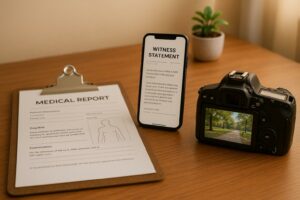Want to know how much you could claim for a personal injury? Here’s a quick breakdown:
- Economic Damages: Covers measurable losses like medical bills, lost wages, and property damage. Example: If your medical bills are $14,000 and you lose $1,500 in wages, that’s $15,500 in economic damages.
- Non-Economic Damages: Compensates for pain, suffering, and emotional distress. Typically calculated using a multiplier (1.5–5× your economic damages) or a daily rate (per diem).
- Key Factors Affecting Compensation:
- Severity of injury
- Long-term effects (e.g., permanent disability)
- Documentation strength (medical records, lost wages, etc.)
- Fault share and insurance limits
Quick Tip: Accurate documentation and consulting a personal injury lawyer can maximize your claim. Keep records of all expenses, pain levels, and lifestyle changes.
Want details? Keep reading to learn how to calculate your claim step by step.
Adding Up Economic Damages
Economic damages refer to measurable financial losses, often forming the core of personal injury compensation. These losses are backed by records and documentation, making them easier to calculate compared to non-economic damages.
Medical Bills and Costs
Medical expenses are typically the largest part of economic damages. These include both immediate and ongoing costs, such as:
- Immediate Care: Ambulance rides, ER visits, hospital stays
- Ongoing Treatment: Physical therapy, specialist consultations, prescription medications
- Diagnostic Tests: X-rays, MRIs, CAT scans
- Related Expenses: Travel costs for medical appointments
| Medical Expense Category | Examples |
|---|---|
| Immediate Care | Ambulance, ER visits, hospital stays |
| Ongoing Treatment | Physical therapy, specialist visits, medications |
| Diagnostic Tests | X-rays, CAT scans, MRIs |
| Related Expenses | Travel costs to medical appointments |
For long-term injuries, it’s crucial to estimate future medical costs. Experts in medicine and finance can help project these expenses, accounting for changing treatment needs and inflation rates.
Income and Work Losses
Lost income is another major part of economic damages. The calculation depends on your employment type:
- Hourly Workers: Multiply the number of hours missed by your hourly rate. For example, if you earn $20/hour and miss 100 hours, your loss is $2,000.
- Salaried Employees: Divide your annual salary by 260 (workdays) and multiply by the number of days missed. Don’t forget to include lost benefits.
- Self-Employed Individuals: Use past tax returns to calculate average monthly earnings. For instance, if you typically earn $5,000 per month and miss three months, your lost income totals $15,000.
Lost income also covers reduced earning capacity and missed benefits, which can significantly increase the total amount.
Other Financial Losses
Economic damages can extend beyond medical bills and income loss. These might include:
- Property repair costs
- Home modifications for accessibility
- Additional transportation expenses
- Lost household services
- Legal fees, if applicable
These additional costs can further impact the total compensation you may seek.
Calculating Non-Economic Damages
Non-economic damages compensate for the less tangible effects of an injury – things like physical pain, emotional distress, and disruptions to daily life. While these don’t come with a direct price tag like medical bills or lost wages, there are standard methods to estimate their worth.
Pain and Suffering Calculations
This type of compensation covers physical discomfort, emotional struggles, and mental anguish. Two common methods are used to calculate these damages:
| Calculation Method | How It Works | Best For |
|---|---|---|
| Multiplier Method | Multiply economic damages by a factor (1.5–5) | When the recovery timeline is clear |
| Per Diem Method | Assign a daily rate, then multiply by the number of affected days | When the recovery period is well-defined |
Insurance companies tend to favor the multiplier method. The specific multiplier is influenced by factors like how severe the injury is, how long recovery takes, and how much the injury affects daily life. Keeping track of how your injury impacts your routine is crucial, as explained below.
Impact on Quality of Life
Documenting how your injury affects your quality of life is key. This includes changes to your physical abilities, daily routines, hobbies, relationships, and mental well-being.
"Non-economic damages compensate for injuries that lack direct financial documentation. They address physical pain, emotional distress, and the disruption of normal life." – Justia
To strengthen your claim, gather statements from doctors, therapists, and even family members. Keeping a detailed journal of your pain and how it affects your life can also be very helpful.
Practical Examples of Calculation Methods
Here’s how these methods work in real-life scenarios:
Per Diem Example:
A carpenter recovering over six weeks calculated $5,040 in pain and suffering damages. This was based on a daily rate of $120 over 42 days.
Multiplier Method Example:
A severe accident resulted in $27,320 in economic damages. Using a 4× multiplier for pain and suffering, the total reached $109,280, bringing combined damages to $136,600.
Insurance companies often lean toward methods that result in lower payouts for non-economic damages.
sbb-itb-68ed374
What Affects Settlement Amounts
Several factors play a role in determining personal injury settlements, shaping expectations for compensation.
Injury Type and Long-term Effects
The type and severity of your injury are major factors in calculating compensation. Severe injuries that require extensive care or lead to permanent disabilities typically result in higher payouts.
Here’s a breakdown of how different injuries impact settlements:
| Injury Type | Settlement Range | Key Factors |
|---|---|---|
| Soft Tissue | $10,000 – $50,000 | Treatment length, recovery time |
| Broken Bones | $20,000 – $150,000 | Surgery needs, complexity |
| Brain Injuries | $50,000 – $1M+ | Severity, lasting effects |
| Spinal Cord | $250,000 – $2M+ | Disability level, ongoing care |
Long-term effects can significantly increase settlement amounts. For instance, a severe fracture that requires multiple surgeries and limits mobility permanently will likely result in a much higher payout than a simple fracture that heals fully. Detailed documentation is critical to support these claims.
Proof and Documentation
Strong evidence is key to securing a fair settlement. Essential documentation includes:
- Comprehensive medical records showing treatment and recovery
- Expert testimony regarding long-term impacts
- Records of all injury-related expenses
- Proof of lost wages and reduced earning potential
- Evidence of lifestyle changes and limitations
These records can make a significant difference in negotiations, especially when liability and insurance limits come into play.
Fault Share and Insurance Limits
In Florida, the pure comparative fault system affects your compensation. If you’re partially at fault, your settlement will be reduced by your percentage of responsibility. For example, if you’re 30% at fault in an accident with $100,000 in damages, your compensation would drop to $70,000.
Insurance limits can also cap your settlement. If damages exceed the at-fault party’s policy limits, you may need to explore additional avenues to recover the full amount.
To improve your chances of a higher settlement, avoid admitting fault and let experienced legal professionals handle negotiations with insurers. Factors like injury severity, the strength of your evidence, fault distribution, and insurance limits all combine to shape your final settlement.
5 Steps to Estimate Your Compensation
Collect Your Records
Start by gathering all the necessary documents related to your injury. Here’s what you’ll need:
| Document Type | Details to Include | Purpose |
|---|---|---|
| Medical Records | Treatment history, medications, specialist visits | Shows the extent of your injury and care costs |
| Financial Documents | Bills, receipts, invoices | Confirms out-of-pocket expenses |
| Employment Records | Pay stubs, W-2 forms, profit and loss statements | Proves income loss |
| Accident Evidence | Police reports, photos, witness statements | Provides key details about the incident |
| Personal Journal | Daily notes on pain levels and activity limits | Tracks the ongoing effects of your injury |
Once you’ve collected everything, organize these records to calculate your financial losses.
Total Your Financial Losses
Start by calculating lost wages:
- For hourly workers: Multiply your hourly rate by the number of hours missed.
- For salaried employees: Divide your annual salary by 2,080 (the typical yearly work hours) and then multiply by the hours missed.
For example, if you earn $30 per hour and missed 32 hours of work, your lost wages would be $960. Add to this any expenses, like emergency treatments or follow-up care, to get a clear picture of your financial losses.
Calculate Non-Financial Impacts
Next, evaluate how the injury has affected your life in non-financial terms. Use records like:
- A daily journal or photos showing pain levels and activity limits
- Medical records detailing physical restrictions
- Reports from mental health professionals
- Statements from family members describing lifestyle changes
These details help support a claim for non-financial compensation.
Consider Limiting Factors
Be aware of factors that could affect your compensation. Permanent injuries or disabilities often lead to higher settlements because of their long-term impact on your life.
Get Legal Help
Finally, consult a personal injury lawyer. They can help refine your calculations to meet state-specific rules and ensure no part of your claim is overlooked. This step ensures all aspects of your compensation are accurately accounted for.
Conclusion
Types of Damages Overview
When pursuing personal injury compensation, there are two main categories to understand: economic damages (measurable financial losses) and non-economic damages (emotional and lifestyle impacts). Each type requires specific documentation and methods to properly calculate and support your claim.
Importance of Documentation and Legal Guidance
Building a strong case hinges on detailed records and professional legal assistance.
Here’s what you should do:
- Keep detailed records of all medical treatments, related expenses, and how the injury affects your daily life.
- Track lost income and work hours due to your injury.
- Document every injury-related cost, even minor ones.
- Maintain a personal journal to note pain levels, emotional struggles, and lifestyle changes.
"The person liable for the injury (or that person’s insurance company) is responsible for reimbursing the injured party for all expenses related to their injury, as well as compensating the injured party for any pain, suffering, or emotional damage they experienced as a result of the injury".
With proper documentation and legal expertise, you’ll be in a better position to estimate and pursue fair compensation.
Next Steps to Take
Follow these five actionable steps to move forward effectively:
- Gather all your records and documents related to the injury.
- Calculate your economic damages, such as medical bills and lost wages.
- Evaluate non-economic damages using methods like the multiplier approach.
- Account for any factors that could influence your settlement amount.
- Consult a personal injury lawyer to review your case.
Most personal injury attorneys work on a contingency fee basis, usually taking 33% to 40% of the final settlement.
"Estimates provided by a personal injury calculator are not guaranteed numbers, but they can offer you an idea of the values that you could use to begin settlement negotiations".
The final settlement amount will depend on various factors, including the severity of your injuries, the strength of your evidence, and the limits of the insurance policies involved. Partnering with an experienced attorney ensures all damages are considered, while also meeting any state-specific legal requirements.




